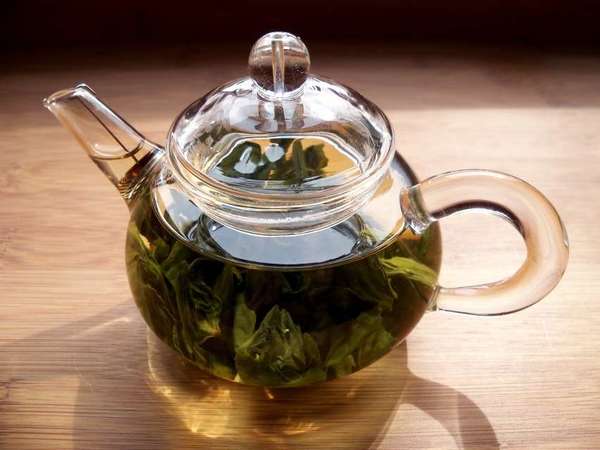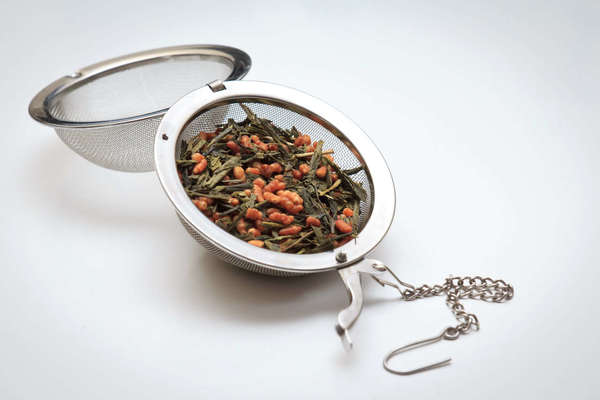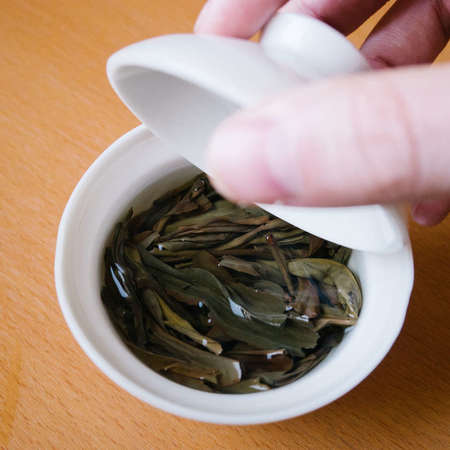Brewing Tea
Wikipedia: Tea#PreparationLast Updated: Aug. 28, 2018
 Tea is often prepared by steeping in a teapot. This glass teapot allows you to see the leaves and the tea as they steep. Photo © A Girl With Tea, CC BY-SA 2.0
Tea is often prepared by steeping in a teapot. This glass teapot allows you to see the leaves and the tea as they steep. Photo © A Girl With Tea, CC BY-SA 2.0Different teas are typically brewed in different ways. Improper brewing can lead to unpleasant characteristics, ranging from teas being weak or thin to being too bitter, sour, or astringent, sometimes even to the point of being undrinkable. However, proper brewing of teas can bring out various pleasing aspects of the aroma and/or flavor.
Brewing is largely a matter of personal taste, and different people may enjoy brewing the same tea in different ways.
The main variables in brewing tea are:
- Amount of leaf (or number of tea bags)
- Water temperature
- Steeping time
- Brewing vessel (and infuser)
- Water quality
 A tea infuser or strainer is usually needed for brewing loose-leaf tea. Pictured here is a tea ball, one of the most common types of infusers. Photo ©Matt Gibson, CC BY-SA 3.0
A tea infuser or strainer is usually needed for brewing loose-leaf tea. Pictured here is a tea ball, one of the most common types of infusers. Photo ©Matt Gibson, CC BY-SA 3.0How to brew loose-leaf tea?
Loose-leaf tea often requires a bit more work (and sometimes equipment) to brew relative to teabags.One of the best ways to brew loose tea is to place loose leaves directly in a teapot and then strain the leaves out when pouring the tea to serve. This technique works best for whole leaf teas. Many teapots have built-in strainers, or you can place a strainer over each cup while pouring.
Another option can be to use a tea infuser (such as a tea ball or cylinder) that sits inside a teapot or mug and contains the tea. When using an infuser, make sure to use one that gives the leaves enough room to expand, and that has a mesh with enough space for water to flow through, so as to bring out the flavor and aroma in the brewed cup.
Most loose-leaf tea companies sell a variety of tea infusers and teapots suited to brewing the types of tea they sell.
What about tea bags?
Brewing tea bags is straightforward, but it is worth noting that different tea bags can contain different amounts of leaf. Inexpensive brands may have as little as 1.2 grams of leaf per bag, whereas others are over 3 grams. Some bags are meant for multiple servings.When using tea bags, the main issues in brewing are steep time and water temperature. You can vary the strength of brewing only by changing the amount of water used or using multiple bags.
Use different temperatures for green, black, white, or oolong tea
Different varieties of tea require different brewing technique for the best drinking experience. The optimal brewing temperature for tea is a question of personal taste, and the guidelines given here are only a starting point to help you discover what works best for you. Typically, black teas are brewed with boiling water, and green teas with water well below boiling, ranging from 160-180°F (72-82°C), and sometimes lower.Most companies recommend brewing white teas with lower-temperature water because they are "more delicate", but many white teas actually taste fine with hotter water. Similarly, many companies recommend brewing oolong teas with water between the recommended temperatures for green and black teas, around 190-200°F (88-93°C), but oolong often tastes fine when steeped with hotter water. Herbal teas are very diverse and hard to generalize about, but most are brewed with boiling water, and some even need to be decocted (continually boiled), a process almost never used for tea.

We also have an article that goes into more depth about the best brewing temperature for different teas.
 Tea Leaves Steeping in a Gaiwan, Photo by Etienne FAT, © Etienne FAT, CC BY 2.0
Tea Leaves Steeping in a Gaiwan, Photo by Etienne FAT, © Etienne FAT, CC BY 2.0Steep whole-leaf tea longer than broken-leaf tea
Whole-leaf tea typically requires a longer steeping time because water diffuses slowly through the intact leaves. Broken-leaf tea, especially fine particles such as the fannings or dust used in most teabags, infuses very quickly.Some finely-broken leaves can rapidly acquire unpleasant bitterness or astringency if left to steep too long. In general, fannings often steep in two minutes or less, and whole-leaf tea frequently requires 3 minutes or more, although this varies greatly from tea to tea and is also a matter of taste.
Experiment!
Brewing tea is a matter of taste. People often enjoy brewing tea at different temperatures or for different lengths of time from those recommended by the tea company, tea experts, or their friends. Experiment with brewing each tea in different ways, and figure out which way you like best. Also consider experimenting with multiple infusions, especially if you are brewing whole-leaf oolong, pu-erh, or green tea. Use this page and the recommendations of others as a suggestion, not an authoritative guideline.External guides on brewing tea:
- Life in Teacup's Guide to Brewing Tea - An interesting and somewhat unusual perspective, most useful for brewing tea in the Chinese style, especially useful for oolongs.


